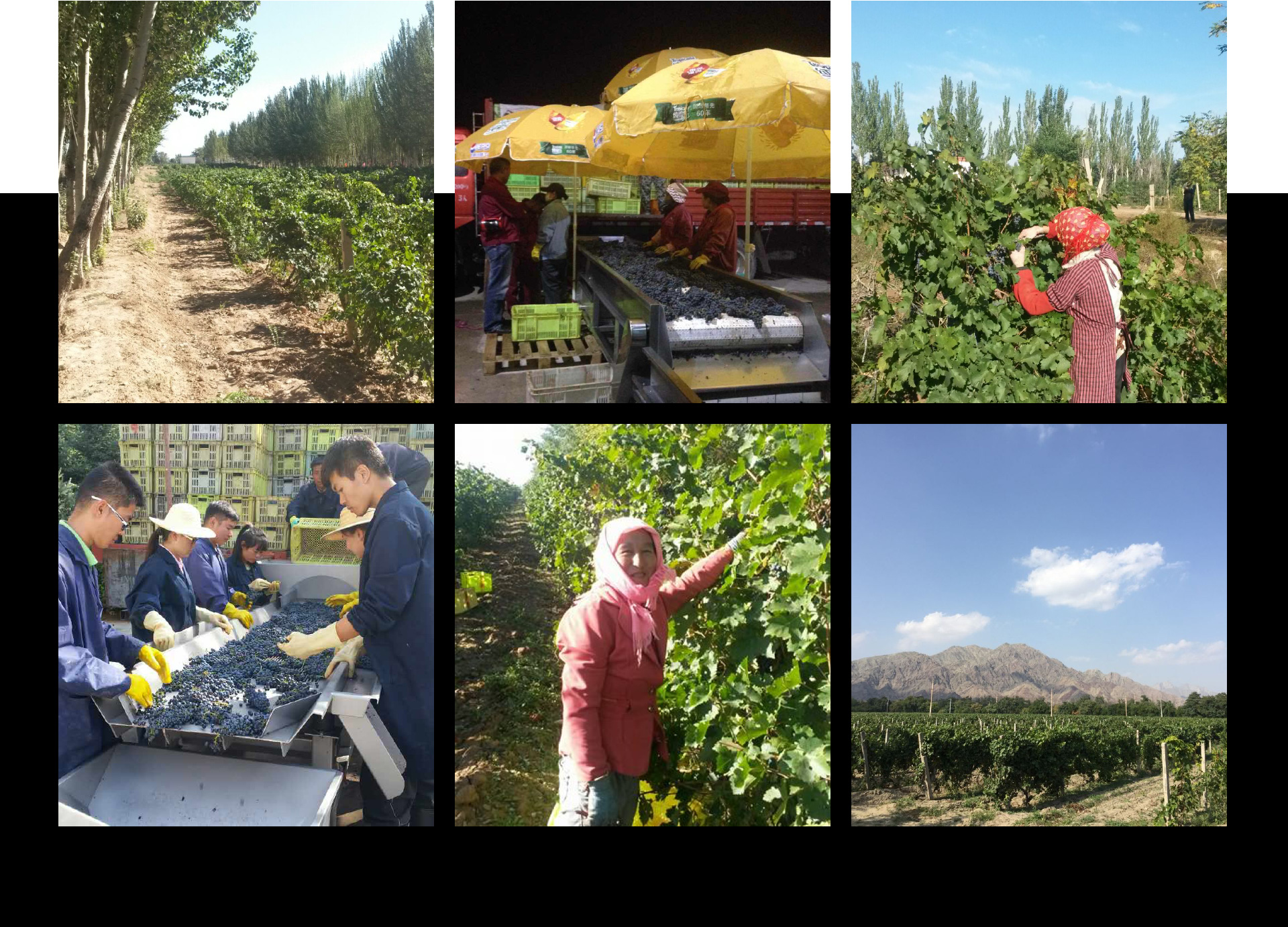My experience making wine at Helan Fang Hau Vineyards, Ningxia, China 2015 - 2017
Ningxia opened a whole new world of wine possibilities to the international arena. Not only is the area catapulting at a great pace but is also terroir and cultivar driven and most well-known for Cabernet Sauvignon, the star or Ningxia. The vast dramatic landscape of mountains, river and desert is part of the enigma of Ningxia that makes it so intriguing. Ningxia is located just south of the Mongolian border between the Helan Mountains, the Yellow river and the Gobi desert.
Most international winemakers have not dealt with such extreme weather conditions and vines being buried completely under soil for the winter months to protect them from freezing. At the beginning of Springtime, the vines are dug up again with great manual labour and readied for budding. This technique of winter burial explains why the vineyards appear un-kept during budding time. But it does not seem to detract at all from the quality of the fruit that the vineyards bear. I have been in Ningxia in different seasons and have seen the vineyards, buried under soil, in full summer and at harvest time that gave me a good understanding of Ningxia vineyards. I think Cabernet Sauvignon will be the most successful cultivar in Ningxia with Chardonnay as a good white cultivar option. Petit Verdot and Syrah as alternative reds could make their mark. As new cellars are finished and technology is added, wine making will become less problematic and more streamline.
Currently, many cellars are temporary structures without all the technology or is unfinished that makes it difficult at times during harvest and wine making. In the Southern hemisphere, like South Africa, we are not used to heating in the cellar even in winter. There were some challenges during wine making in Ningxia with electricity cuts and therefor lack of cooling at times. But problem solving is part of the skills you need to make wine in different countries and different cellars. The Chinese government is investing heavily into the area along with private owners on a 50/50 basis and some cellars and tasting facilities that have been finished are extremely extravagant, some even have walking conveyer belts in the cellar.

It can be quite a challenge to make wine in an area where English is not widely spoken but we managed quite well in the cellar with translators. The Ningxia vineyards are flat and easy to harvest. I made wine for a French/ Chinese company in the Shangri-La district of Yunnan in 2016 and the vineyards were planted on extreme mountain slopes and he steep banks of the Mekong river that made harvest difficult and slow. My Ningxia Cabernet Sauvignon grapes were harvested much later than many others and it provided me with more optimal ripeness and I did not have a problem with the green character often found in wines from the region. I also removed the pips during fermentation that was time consuming but effective. I think my Ningxia Cabernet was very successful and I made the product I planned to make.
I took samples of my Ningxia wines to a Wine Master for tasting. He commented the wine had Bordeaux character similar to Pauillac. The challenge of the region is to eliminate the green character from its Cabernet. This can be done by skilled experts in the vineyard and cellar working together. There seems to be a dominating fascination of French wines and perhaps Ningxia can be to China what Boudreaux is to France.
I was always welcome at the winery and soon found my way around by foot or motorbike. I even made friend with the local cellar dog that followed me everywhere. The Chinese people are extremely friendly, helpful and inquisitive. I spend some time teaching students from a winery school and their dedication is fantastic. Wine training is part of my passion for wine and I love sharing knowledge and presenting tastings.
I had a great time getting to know the other wine makers from around the world and we had some good laughs. I even ended up attending a Chinese wedding with David Tyney and Kiki. I expect that if the Chinese government keep up with the pace of expansion in Ningxia, the culture of wine appreciation will continue to grow in China. For it to be successful, there must be a lot of emphasis on wine education and international tasting. The pace of expansion must be balanced with the quality and price ratio. It can only grow at this pace with a great deal of winemaker consultants contributing to making quality wines across the region. If the cellars are extravagant and the area is marketed but the quality is lacking buyers will go back to buying imported wines.
Once the proposed systems are in place and international wine makers invest their skills and training into the local workforce, China can become more independent in its production of world class wines. It will take some years to affectively educate Chinese winemakers, cellar and vineyard staff and time is needed for them to gain experience internationally. Winemaking is not merely following a recipe, you need to be able to adapt to different situations and be able to overcome the challenges in difficult harvest years. This comes with time and experience.
Together with cultural, culinary and adventure activities around the Helan Mountain, the Gobi Desert and the Yellow River, wine tourism has a lot of potential. Good tourist transport options and attractive wine tasting rooms, restaurants and cellar tours will work together to attract Chinese and international tourists to Ningxia. I was very impressed with the Art Museum in Yinchuan and the invitation for international artists to work in Yinchuan. Bringing all these cultural, adventure, culinary and wine experiences together will create interest for the region. I always enjoy being in China and love the culture, people and especially the food.
